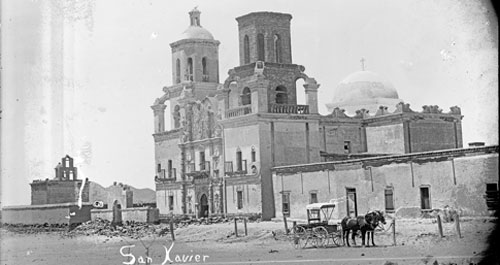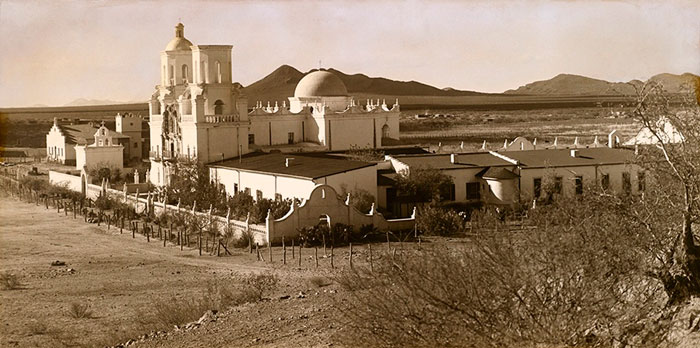History of The Mission
MISSION SAN XAVIER DEL BAC was founded in 1692 by a Jesuit missionary, Father Eusebio Francisco Kino.
That year, he became the first non-Indian to visit the village of Wa:k, or “Bac,” as he wrote it, and it was he who bestowed the patronage of San Francisco Xavier on this large village of O’odham or, as he called the natives, “Sobaipuris.”
Father Kino’s mission field was a large one that included most of what today are the west halves of northern Sonora and southern Arizona. His visits to San Xavier were always brief. In 1700 he spent a week in the village overseeing the laying of foundations for what he hoped would be a large church, but that effort never came to fruition. When Kino died in 1711 the village of Wa:k had neither church nor resident missionary.
Although Jesuits established a sporadic presence at San Xavier beginning in 1732, it was 1756 before construction of the first church was begun. Erected under the tutelage of Father Alonso Espinosa, S.J., it was a flat-roofed, rectangular building constructed of mud adobe and mud mortar. It survives today with the same external configuration but in a different location as the east wing of the mission abutted to the present church’s east bell tower.
Jesuits were expelled from New Spain (Mexico) by the Spanish King in 1767, and the following year Franciscans took up mission posts in the northern Sonoran Desert the Jesuits had been forced to abandon. Father Francisco Garcés became San Xavier del Bac’s first Franciscan missionary.
In 1783, Father Juan Bautista Velderrain, a Basque Franciscan who had arrived at San Xavier in 1776, was able to begin construction on the present church. He had borrowed enough money from a Sonoran rancher, using crops of wheat not yet planted as collateral, to hire an architect from Mexico, Ignacio Gaona, and a large workforce of O’odham to build what was to become one of the most outstanding examples of Mexican baroque architecture in the United States.
Father Velderrain died at San Xavier in 1790. His replacement, Father Juan Bautista Llorens, oversaw the decoration of the interior of the church. A painter and sculptor, who have remained anonymous, came to the Mission from Mexico and large numbers of statues of religious figures were imported that had been fashioned in guild workshops in Mexico. By 1797, funds exhausted and the Mission’s creditor complaining, work stopped – including that on the east bell tower – and the church opened its doors for services.
Mission San Xavier, a part of New Spain, became a part of the new Republic of Mexico in 1821. Mexican material support for missions was non-existent, and in 1837 San Xavier’s last resident missionary in the 19th century departed the premises. Franciscan administration of all missions in the region came to an end in 1843 and secular clergy assumed responsibility for the churches, a circuit-riding Mexican priest visiting San Xavier perhaps once a year until the Mission became a part of the United States in June, 1854 with approval of the Gadsden Purchase.
In 1859, San Xavier became part of the Diocese of Santa Fe and the Bishop of Santa Fe tried without much success to find clergy to assign to Tucson and San Xavier. Finally, in 1866, Tucson became an incipient diocese (vicariate apostolic) and the local vicar apostolic began sending secular clergy who lived in Tucson to the Mission for regular visits and to conduct services. Sisters of St. Joseph of Carondelet took up residence at San Xavier and opened a school in 1872. The nuns who now operate the school at the Mission are Franciscan Sisters of Christian Charity from Manitowoc, Wisconsin.
The church and school continue to serve descendants of the O’odham for whom the Mission was founded in 1692, and they remain a crucial hub in the spiritual, educational and social life of the community of Wa:k, the San Xavier District of the Tohono O’odham Nation.

Fast Facts
1692-1899
• 1872
The Sisters of St. Joseph of Carondelet open school at the Mission. The nuns who operate the school today are Franciscan Sisters of Christian Charity.
• 1866
Tucson becomes an incipient diocese and clergy regularly visit the Mission and conduct services.
• 1859
The Mission falls under the jurisdiction of the United States and the Diocese of Santa Fe and the first fixes to the structure begin.
• 1797
Funds are exhausted, work stops, and the church opens its doors for services.
• 1790
Franciscan father Juan Bautista Llorens begins overseeing the decoration of the interior of the church.
• 1783
Under the direction of Franciscan Father Juan Baptiste Velderrain, construction of the great church begins, paid for with 7,000 pesos borrowed from a Sonoran rancher.
• 1756
Father Alonso Espinosa, a Jesuit, builds the first church−a one-room adobe mud hut structure−on the Mission site in.
• 1692
Jesuit missionary Father Eusebio Francisco Kino establishes the Mission San Xavier Del Bac.

